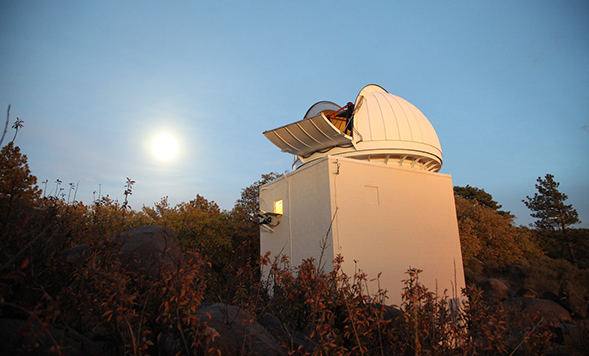Shooting for the Stars
A new telescope will allow SDSU astronomers to look further into the galaxy with a more powerful, detailed lens.

Observatory staff are in the process of completing the installation of the new 50-inch Phillips Claud Telescope, funded in part by a donation from the late Phillips L. Claud Jr.
The Mount Laguna Observatory, which is owned and operated by SDSU, sits 6,100 feet above sea level in the Laguna Mountains of eastern San Diego County.
The automated telescope is 50 percent more powerful than the previous model, and will allow professors, undergraduate and graduate students to look further into the galaxy with the more powerful, detailed lens.
“It would help a lot of students, especially graduate students,” Jaimes said. "We are very fortunate to be using it and to have modern state of the technology to work with.”
Jaimes received his undergraduate degree in astronomy from SDSU and is now continuing his education in the master’s program as a graduate teaching assistant.
He is currently in his third semester of teaching students.
Before continuing his education in the master’s program, Jaimes spent two years at Columbia University as a full-time research assistant.
Jaimes’ research at Columbia University mostly consisted of finding the spectra of stars and observing the rotational patterns stars make.
“My research is looking at the spectra of transient objects, things that suddenly become really, really bright, such as supernova explosions,” Jaimes said.
Jaimes said the 50-inch telescope would allow him to continue his research and gather data in specific areas.
“If we had two telescopes, one could be doing photometry, measuring the brightness of objects, and the other telescope could be observing at the same time, so we could add in the spectrograph in order to take the spectra of stars,” Jaimes said.
He continues to use the 40-inch telescope that’s currently installed at the observatory, but says the advantages of the soon to be completed 50-inch telescope are unlimited.
According to Jaimes, the approximate seven-inch difference in diameter of the two telescope’s mirrors corresponds to a 37 percent greater light gathering power.
This will allow for a better and more detailed look at fainter objects.
Mount Laguna Observatory Director Robert Quimby noted the impact the 50-inch telescope could have on graduate students.
“It could open up a different style of research projects,” Quimby said. “Right now we have telescopes that require students to operate during nights, and it’s difficult for them to carry out these observing programs while they are enrolled as full-time students."
Astronomers are required to put forth a significant amount of time and effort in order to track down data. With the improved automation of the new telescope, enhanced research opportunities arise.
“This would open up a program where students could potentially have observations taken on many nights, where as now there are only a few times of the month they can do this,” Quimby said.
The completion date of the Phillips Claud Telescope installation has not been announced.
This article originally appeared in The Daily Aztec.



